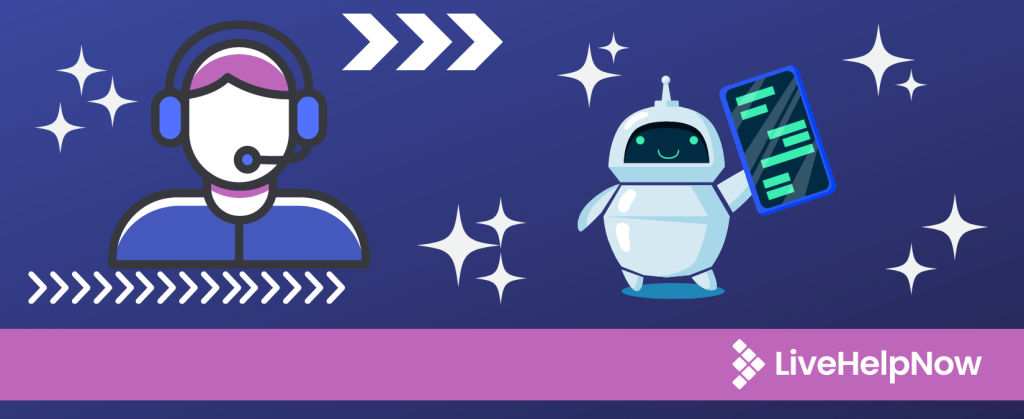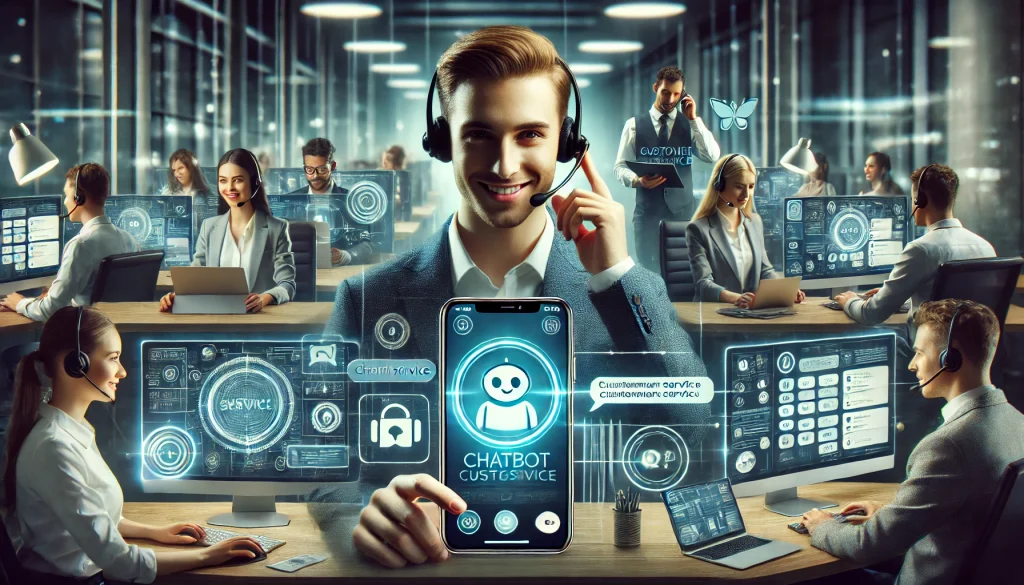Deciding whether to adopt a chatbot as part of your customer service plan can be intimidating. Will customers use it? Will the quality of my customer service suffer? What about operational cost savings?
We want to make your research process as simple as possible. We’ve put together some of the most common questions businesses ask before adopting a chatbot customer service with the answers you’ll need to make a decision.

1. How can chatbots improve my customer service operations?
Here are some of the ways that chatbots can improve your customer service:
24/7 Availability: A chatbot can handle customer queries even after business hours. You’ll be able to provide around-the-clock service to customers who seek support outside of regular business hours.
Instant Response: Nobody likes long wait times or being stuck on hold. With response time being crucial to a customer-centric business, chatbots can provide customers with immediate responses to their questions.
Scalability: Chatbots can manage multiple customer interactions at once without the addition of more staff members. Due to this scalability, even in times of high demand or peak usage, customer inquiries are promptly handled.
Cost Efficiency: Chatbots help reduce customer service costs by automating routine or repetitive tasks. They can handle frequently asked questions, provide self-service options, and perform basic troubleshooting. This frees up human agents to focus on more complex and important customer issues. Businesses can also cut back on support training if a chatbot is handling a percentage of that work.
Consistent Support: A chatbot can provide a consistent user experience without the need for a robust support infrastructure. When using a chatbot, agent productivity doesn’t factor into business productivity nearly as much.
2. What types of customer inquiries can chatbots effectively handle?
Depending on the chatbot you choose to use or create, it can address many different kinds of customer inquiries. Here are the most common types of inquiries that chatbots handle:
Frequently Asked Questions (FAQ): Chatbots excel at answering common queries and providing information about basic product/service details, pricing, shipping, or return policies.
Order Tracking: Chatbots can provide the latest updates on orders, tracking numbers, and delivery dates. This saves customers the time and effort of contacting customer support agents for tracking information that can be easily delivered without the need for human interaction.
Technical Support: Chatbots can handle basic technical issues, such as troubleshooting common or frequent problems, providing simple instructions, or suggesting solutions to commonly encountered errors.
Account Assistance: Chatbots can help customers access their accounts and make password changes. They can also update account information such as address or phone number, manage subscriptions, or make payments. Additionally, utilizing a password manager can enhance account security and simplify password management for users.
Booking and Reservations: Chatbots can create bookings or reservations for appointments, flights, hotels, restaurants, and anything else that requires appointments. This streamlines the process without the need for human engagement.
Customer Feedback and Surveys: Chatbots can collect customer feedback, conduct surveys, or solicit reviews after a purchase or interaction. Organizations can better understand how visitors interact with their website and business and find ways to improve.
General Support: Chatbots can handle general questions related to operating hours, business addresses, specific company policies, and store locations. This eliminates the part of the call volume that doesn’t require a human support agent.
Billing and Payment Assistance: Chatbots can help customers with billing issues, payment methods, refunds, or invoice issues. Some payment or billing concerns will need an agent’s intervention, but for most inquiries, a chatbot is a great solution.
Warning ⚠️⚠️⚠️
Chatbots can offer many types of proactive support. But be careful not to set yourself up for failure. If your chatbot can’t handle a specific problem or query, don’t force it.
3. How do chatbots assist with reducing customer support costs?
In short, chatbots reduce customer support costs by reducing the number of interactions customers need to have with a live agent. Here are a few other ways chatbots can reduce customer support costs:
Provide After-Hours Support: If you have a live agent on staff that handles after-hours support, consider if a chatbot could fill in for that agent. Volume is usually very low overnight, depending on the business.
Reduce Call Volume: Chatbots can act as a sort of filter. Customers whose issues can be addressed with the help of a chatbot won’t need to contact a live agent. This frees up bandwidth for your customer support team to handle more complicated issues.
4. Can chatbots integrate with existing customer service platforms and systems?
Yes, chatbots often integrate with popular platforms related to customer service. However, not all chatbots will integrate with all platforms. As you’re choosing a chatbot, make sure it integrates with the other platforms and tools your business uses. Chatbots will often integrate with the following:
Websites: Chatbots can be incorporated into the live chat feature of the website. This enables them to interact with visitors, respond to questions, and help with inquiries in real time. When used well, they can become a part of the customer journey.
Messaging Services: Chatbots can be integrated with popular messaging services like WhatsApp or WeChat. This allows businesses to provide customer support through these widely used platforms.
Social media: Chatbots can interact with customers on social media channels like Facebook Messenger or Twitter by integrating with those sites.
Customer Relationship Management (CRM) Systems: Integration with CRM systems allows chatbots to access customer information and history, providing a personalized customer experience and contextualized responses. This is one of the most powerful integrations for chatbots and allows them access to customer service history and more.
Knowledge Bases: Chatbots can access accurate and current information to provide accurate answers to customer inquiries by integrating with knowledge bases.
E-commerce Platforms: Chatbots can work with e-commerce platforms to help shoppers find products, get recommendations, and track their orders. They can provide personalized responses based on shopping or browsing history on the site.
There are plenty of other integrations available for chatbots. Check with as many chatbot providers as you can to see which integrations are right for you.
Related Read: What to Look for in a Great Customer Service Chatbot
5. What level of customization is possible with chatbots to align with my business’s brand and voice?
Different chatbots will offer different levels of customization, but most chatbots will give you control to some degree over the following areas:
Personalized Greetings: You can write unique greetings that express the voice and character of your brand for a more engaged audience.
Predefined Responses: Tailor the chatbot’s responses to reflect the principles of your company while offering accurate information.
User Interface: A chatbot’s user interface can often be tailored to match your brand’s colors, logos, and overall design aesthetic.
Language and Tone: Chatbot language and tone can often be modified to match your brand’s communication style, whether it’s friendly, professional, or casual.
Special Promotions or Messages: Integrate special promotions, announcements, or marketing messages into the chatbot’s responses that fit with what your business is offering.
Error Handling: When the chatbot comes across a question it can not answer, customize error messages and responses to be beneficial and brand-appropriate.
Multilingual Support: Some chatbots have multilingual capabilities. If this is an absolute need for your business, make sure you look for chatbots that specifically offer this support in the languages you’re looking for.

6. Are chatbots capable of understanding and responding to industry-specific terminology or jargon?
Chatbots can be programmed to respond to any number of queries, no matter what industry-specific terminology is used. As long as the customer’s inquiry is understandable, a chatbot can respond to it.
This may be more difficult as customer service scenarios become more complicated. As you’re testing out chatbots, make sure you include specific terminology as a way to gauge a chatbot’s capabilities. Also, test out human speech. Use slang, misspellings, and other common vernacular to see how the bot responds. The last thing you want to do is fall short of customer expectations and fail to provide customer satisfaction by promising automation but failing to deliver.
7. Can chatbots be programmed to handle sensitive customer information securely?
Privacy and data protection are essential elements of a good chatbot. Make sure that the chatbot you’re planning on using has robust security in place and that you’re comfortable giving it access to customer information.
You’ll definitely want to verify what your chatbot provider is doing to keep private information secure. With all this being said, a chatbot with access to customer accounts means that it can help customers with basic account functions, understand customer context, and see the flow of the customer’s journey. All of this frees up a lot of time for your service team.
Related Read: Ebook – HIPPA Compliance and Live Chat
8. What resources and expertise are needed to develop and maintain a chatbot for customer service?
Depending on the chatbot, you might not need any experience at all to implement or maintain a chatbot on your website. Many companies offer turnkey solutions that only require you to set up messaging and the user interface of the chatbot.
Other chatbots are custom-built by or for a specific business. These kinds of chatbots are complicated and not for beginners. They often perform advanced functions that many other chatbots aren’t capable of.
9. Can chatbots handle complex or escalated customer issues, or do they require human intervention?
Simple chatbots can handle simple customer issues. More advanced chatbots can generally handle more complex customer issues. However, you’re still likely to need human intervention for some customers’ inquiries.
Related Read: Throwing Curveballs at Chatbots
10. What metrics should I track to measure the performance and effectiveness of my chatbot?
There are many metrics you can look at when it comes to measuring performance. Depending on your business and what your most important metrics will be, consider tracking the following:
Response Time: Measure how quickly the chatbot responds to customer inquiries. A low response time indicates a quicker response to the customer and a higher chance of a positive interaction.
Resolution Rate: Track the percentage of customer inquiries that the chatbot successfully resolves without the need for human intervention.
First Contact Resolution (FCR) Rate: Similar to resolution rate, this metric measures the percentage of customer inquiries resolved on the first interaction with the chatbot.
Escalation Rate: Track the percentage of interactions where the chatbot transfers the conversation to a human agent due to either the complexity of the issue or user frustration.
Abandonment Rate: Monitor the percentage of customers who abandon interactions with the chatbot before receiving assistance. This could indicate a problem with the messaging or function of the chatbot.
User Engagement: Track the number of interactions per user and the frequency of users returning to use the chatbot. This indicates how helpful it is to your customer base.
Conversation Length: Monitor the average duration of interactions with the chatbot. You want to aim for short and concise conversations that provide solutions as soon as possible.
Error Rate: Keep track of how often the chatbot fails to understand or provides poor responses to a customer’s inquiry.
11. Can chatbots gather customer feedback or conduct surveys to gather valuable insights?
Yes, customer support chatbots can deliver customer feedback surveys after successful interactions, on websites, and in a number of additional ways. This survey data can be used to improve the chatbot itself, the website, and other areas of a business.
Chatbot surveys are a great way to gauge customer sentiment related to chatbot use. They can also help you plan for chatbot inclusion in your future support strategy.
12. What level of training and ongoing maintenance is required to ensure the chatbot’s optimal performance?
Each chatbot will have its own learning curve when you get started. Depending on which chatbot you use and how it was designed and built, the training time will differ. A simple chatbot doesn’t require much training at all.
However, as you begin using the more advanced features offered by chatbots, you’ll have to continuously refine and train the chatbot to ensure it’s providing adequate responses to your customers. This training and maintenance can take a good amount of time, especially for AI-powered customer service chatbots. Once the chatbot digests conversational design and conversation history with customers, its ability to carry out personalized conversations will increase.




